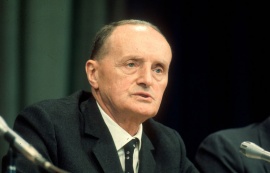Manlio Brosio
( lawyer, diplomat, politician) | ||||||||||||||||
|---|---|---|---|---|---|---|---|---|---|---|---|---|---|---|---|---|
 | ||||||||||||||||
| Born | 1897-07-10 Turin, Italy | |||||||||||||||
| Died | 1980-03-14 (Age 82) Turin, Italy | |||||||||||||||
| Nationality | Italian | |||||||||||||||
| Alma mater | University of Turin | |||||||||||||||
| Religion | Roman Catholic | |||||||||||||||
| Party | Italian Liberal Party | |||||||||||||||
The last Secretary General of NATO who was appointed before he attended the Bilderberg.
| ||||||||||||||||
Manlio Brosio was an Italian diplomat who was appointed Secretary General of NATO in 1964, before attending the Bilderberg meeting next year. At the 1966 Bilderberg, Robert R. Bowie delivered the keynote paper on the topic of NATO's reorganisation, and all subsequent secretary generals have been Bilderberg visitors before being appointed to the job.
Broslio spoke at the seminal 1979 Jerusalem Conference on International Terrorism on "Fighting Terror within the International Framework."
Contents
Official narrative
25 years after Brosio's death, Ryan C. Hendrickson portrayed him as a "Cold War consensus-builder" on the NATO website.[1]
Freemason
Manlio Brosio was a member of Grand Lodge of Italy, known popularly as the "Piazza del Gesù" Freemasons.
Background and early career
While he was a student at the Faculty of Law in Turin, in 1916 he was called up for military service and, after attending officer school, he participated in the First World War as an officer of the elite Alpine troops (in Italian: Alpini).[2]
When the war ended and he resumed his studies, he graduated in 1920 and became a close associate of Piero Gobetti.[2] His adherence to the project of the Rivoluzione liberale (the liberal revolution) of Gobetti led him not to support the fascist government which took power in 1922. Warned by the police in 1927, he distanced himself from any direct political commitment and, during the twenty years of the Mussolini government, he practiced the profession of lawyer.[2]
During the Second World War, after the 1943 armistice, he entered the resistance, becoming a member of the military leadership of the National Liberation Committee as a delegate of the Italian Liberal Party together with Giorgio Amendola (PCI), Riccardo Bauer (PdA), Giuseppe Spataro (DC), Sandro Pertini (PSIUP) and Mario Cevolotto (DL). In particular, among his competences (not having the PLI partisan party formations) was to maintain contacts with the clandestine military Front of Colonel Cordero Lanza di Montezemolo.
At the end of the war he was minister without portfolio in the Bonomi governments, vice-president of the council in the Parri government and minister for the National Council, and again minister, this time of war, in the first executive led by Alcide De Gasperi.[2] After the 1946 referendum oon the monarchy, in which he had expressed himself in favor of the republic, he left the PLI which had sided with a majority for the monarchy.
Diplomatic Career
In 1946 he began his career as a diplomat with the appointment as ambassador to Moscow; in 1952 he moved to London, where he signed the Memorandum of Understanding on Trieste, and then in 1955 became Ambassador of Italy to the USA, where he remained until 1961, moving to Paris.[2]
On 14 June 1962 he signed on behalf of Italy, together with his counterparts from Belgium, Denmark, France, Germany, the Netherlands, Spain, Sweden, Switzerland and the United Kingdom the constitution document of European Space Research Organisation, which in [1975]] merged into the establishment of ESA (European Space Agency).[3]
NATO
On August 1, 1964, he became Secretary General of NATO, the first Italian to get this post, which he held for more than 7 years, until October 1, 1971.[2] A few days before he left office, U.S. President Richard Nixon gave him the Presidential Medal of Freedom.
After leaving [{NATO]] he returned to Italian politics. Senator of the PLI and leader of the liberals in the Senate from 1972 to 1976, in the 1976 elections he was not re-elected and retired from active political life. Appointed president of the Italian Atlantic Committee in January 1979, he held this role until his death in his native Turin, after a short illness.[2]
Events Participated in
| Event | Start | End | Location(s) | Description |
|---|---|---|---|---|
| Bilderberg/1965 | 2 April 1965 | 4 April 1965 | Italy Villa d'Este | The 14th Bilderberg meeting, held in Italy |
| Bilderberg/1966 | 25 March 1966 | 27 March 1966 | Germany Wiesbaden Hotel Nassauer Hof | Top of the agenda of the 15th Bilderberg in Wiesbaden, Germany, was the restructuring of NATO. Since this discussion was held, all permanent holders of the position of NATO Secretary General have attended at least one Bilderberg conference prior to their appointment. |
| Bilderberg/1967 | 31 March 1967 | 2 April 1967 | UK Cambridge University/St John's College | Possibly the only Bilderberg meeting held in a university college rather than a hotel (St. John's College, Cambridge) |
| Jerusalem Conference on International Terrorism | 2 July 1979 | 5 July 1979 | Israel Jerusalem | The birthplace of the "War on Terror" doctrine, "a major international forum for the movement against détente". |